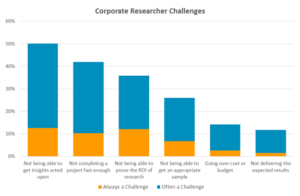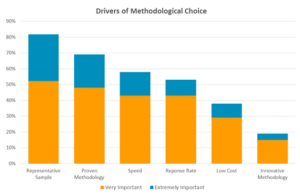Qualitative research is a set of methodologies whose common goal is to explore and uncover the hows and whys of consumer behavior. It’s left to quantitative research to measure the “how much”. The categories of qualitative and quantitative have been easy monikers to differentiate the concepts of exploration compared to confirmation, depth of insight compared to breadth of insight, the immeasurable contrasted to the measurable.
But the lines between qualitative and quantitative are blurring rapidly. While there are numerous reasons for this, two of the main forces are business demands (speed, cost and acting on useful information) and the capabilities afforded by technology.

When corporate researchers were asked about their pain points for the 2016 Quirk’s Corporate Researcher Report – too many projects for staff or budget topped the list as always or often a pain point (60%, 50% respectively). When asked about challenges – corporate researchers noted the inability to for insights to drive action and not being able to complete projects fast enough as always or often a challenge (50%, 42% respectively).

When looking at the newer methods of research, corporate researchers view qualitative tools (as a whole) as more effective at providing actionable insights. “Online qualitative/focus groups” are viewed by 70% of corporate researchers as effective or very effective. Mobile-specific surveys are second (53%). But the next couple are also qualitative techniques – social media research (40%) and text analytics (52%).

Taking the premise that actionable insights are the number one goal for corporate researchers and the number one challenge, and that qualitative research (at least among the newer methods) generally does a better job of providing these insights, then it is likely that more energy will be directed here. At the same time, there is a methodological drag to qualitative research according to this survey. The top four drivers of methodological choice for a project are; representative sample (82% viewed as very or extremely important), proven methodology (69%), speed (58%), and response rate (52%).

While qualitative has never been about representation per se, the scale in some tools is pushing that of quantitative. Some of the newer qualitative tools do have a good way to go before they are as deemed worthy of a wide variety of use cases – but that is changing rapidly.
Technology is changing the nature of qualitative in several different ways:
Recent advancements signal the future of qualitative research. Text analytics improve month by month. Several companies have had different levels of success in identifying emotional context, purchase probabilities, consumer values, and a number of other frameworks that build on our understanding of consumers and their relationship to our products. Other qualitative methodologies have automated processes for understanding the emotional connections consumers develop with products and brands through imagery, metaphors, and other projective techniques. Crowd-sourcing has been in use for several years, but new applications and technologies are able to provide deep understanding of an issue in a cost-effective and timely manner – and at the scale of quantitative research. Artificial intelligence is making its way into marketing research. These tools have been around for a couple of years, but have improved dramatically in the past year. Many of these tools measure delivery in hours or days instead of weeks or months.
In addition, we should start to see the synthesis of mobile sensors, shopping or purchase behavior, and advertising effectiveness over the next year. This puts the depth of qualitative insights in context with behaviors – which is the holy grail of market research.
The future of qualitative research addresses the key pain points of today’s corporate researcher. The lower cost provided by technology and improved user interface will reduce the impact of constrained resources. Technology is also quickly and significantly improving the time to insights. Experience will prove the application to specific use cases. Scale will reduce the concern about sample representation. And most importantly, the quality of insights provided by new qualitative methods has and will continue to improve Many of the newer methods are combining the depth of qualitative with the breadth of quantitative – getting us to the how, the why, AND the “how much”.
This article first appeared in the 2016 Quirk’s Corporate Researcher Report.